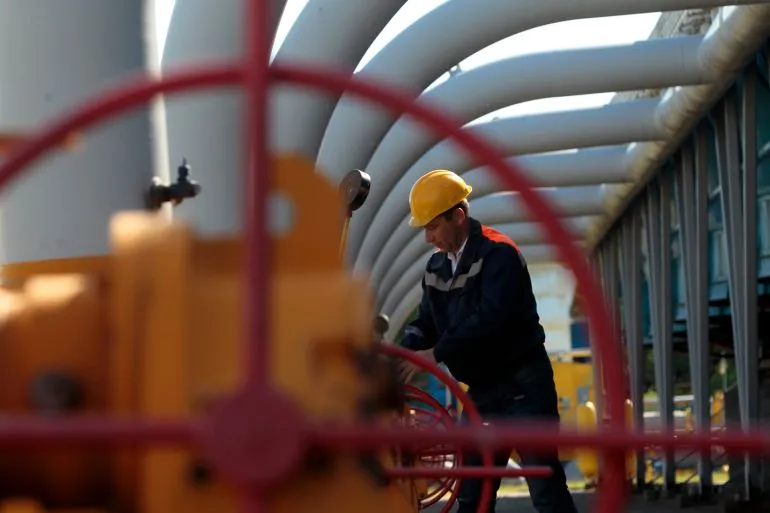Russian gas flows to Europe via Ukraine have ceased, closing a route that has operated for five decades. The stoppage follows Kyiv’s refusal to allow transit that could fund Russia’s ongoing war against Ukraine.
Both sides confirmed the halt on Wednesday after the expiration of a key transit deal, forcing central European countries to seek alternative, costlier gas sources.
The disruption, while accounting for only 5% of Europe’s gas needs, exacerbates the region’s energy challenges. Gas prices have risen 50% year-on-year, fueled by the anticipation of this cutoff and broader energy supply concerns.
The shift leaves Europe increasingly reliant on the global liquefied natural gas (LNG) market, exposing the continent to heightened volatility.
“This termination of gas transit is not just a supply-chain adjustment — it’s the symbolic collapse of an era.
“A significant part of the Soviet-built gas-pipeline network, which once brought Siberian gas to Europe, is now a shadow of its former self.”
Tatiana Mitrova, a researcher at the Center on Global Energy Policy at Columbia University
For Russia, the closure of this pipeline marks a significant financial blow, with annual revenue losses estimated at $6 billion, according to Bloomberg. Ukraine also faces substantial economic consequences, losing out on lucrative transit fees and its strategic role as a vital energy conduit for Western nations.
Central European nations dependent on Russian gas face mounting costs. Slovakia’s largest gas utility, Slovensky Plynarensky Priemysel AS, revealed it would incur an additional €90 million ($93 million) annually to secure stable imports via alternative routes.
The company also warned of increased vulnerability in the event of a harsh winter, with European gas inventories depleting at their fastest pace in years.
The halt in supply follows Gazprom’s decision to suspend deliveries on New Year’s Day, citing Ukraine’s refusal to extend the expired five-year transit agreement. Ukraine’s Energy Ministry confirmed that Russian gas flows across its territory ceased as of 7 a.m. local time.
While immediate shortages are unlikely, the halt complicates efforts to replenish European gas storage ahead of the next heating season. Current inventories have dipped below 75%, raising concerns about energy security in the coming months.
Strategic Shifts and Market Volatility

With piped gas flows to Europe significantly reduced, Russia is expected to intensify its focus on expanding LNG shipments—a long-held ambition of President Vladimir Putin. However, such efforts face obstacles, including Western sanctions and calls within Europe to ban imports of Russian liquefied gas.
Despite these calls, Europe has been buying record amounts of LNG from Russia, underscoring the difficulty of completely phasing out Russian energy supplies. European Commission President Ursula von der Leyen has set a target to eliminate Russian fossil fuel imports by 2027.
A spokesperson for the European Commission noted that the gas stoppage via Ukraine was anticipated and that the EU had prepared for such a scenario over the past year.
Among European nations, Slovakia is expected to be hardest hit. Prime Minister Robert Fico warned of “drastic impacts” on Slovakia and the broader EU, noting that his country earns up to €500 million annually in transit fees from Russian gas flows.
Last month, Fico urged European allies to find ways to maintain the gas supply, even threatening Ukraine with a potential power cutoff to underscore the urgency of the issue.
Ukrainian President Volodymyr Zelenskiy has firmly rejected any agreements that would allow Russia to benefit financially while the war continues. For his part, Putin described future gas transit deals with Ukraine as “challenging.”
Jonathan Stern, a research fellow at the Oxford Institute for Energy Studies, emphasized the difficulty of finding a resolution. “The question is whether anybody in Europe — but especially the Slovaks — will succeed in making an agreement to continue receiving some gas,” he said.
Alternative Routes
Russia continues to supply gas to certain European countries, including Serbia and Hungary, via the TurkStream pipeline, which bypasses Ukraine. However, this route cannot fully offset the loss of the Ukrainian pipeline.
Other pathways, such as those across Poland, have also been closed, and the Nord Stream pipeline to Germany was damaged in explosions in 2022. The newer Nord Stream 2 link remains unauthorized.
Disruptions in Russian gas flows through Ukraine are not unprecedented. In 2009, a two-week halt affected over 20 countries during freezing winter temperatures. A shorter disruption occurred in 2006. The now-expired transit agreement, signed in 2019, was the result of intense last-minute negotiations.
The cessation of Russian gas flows via Ukraine marks the end of a historic energy corridor that has defined Europe’s energy landscape for decades. While the EU has taken steps to adapt, the loss of this route underscores the fragility of the continent’s energy security amid geopolitical tensions.
As Europe faces its most significant energy challenges in years, households and industries must brace for higher costs and a more uncertain supply landscape. The symbolic and practical implications of this pipeline closure will reverberate through energy markets and diplomatic relations for years to come.
READ ALSO: Biden Draws Contrast Between Jimmy Carter And Trump




















